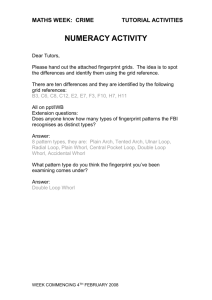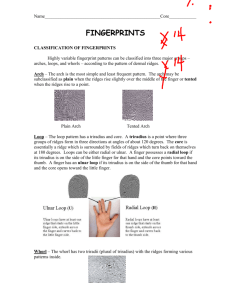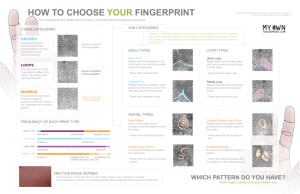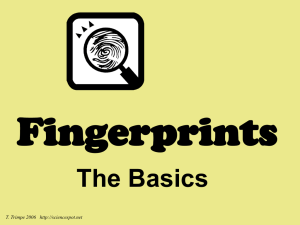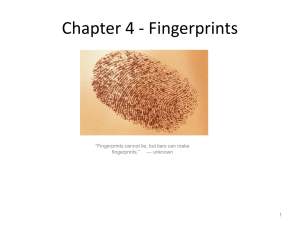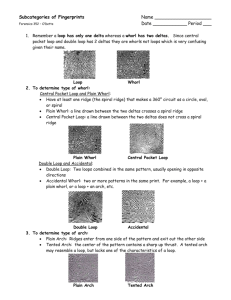Fingerprints - Dermatoglyphics
advertisement
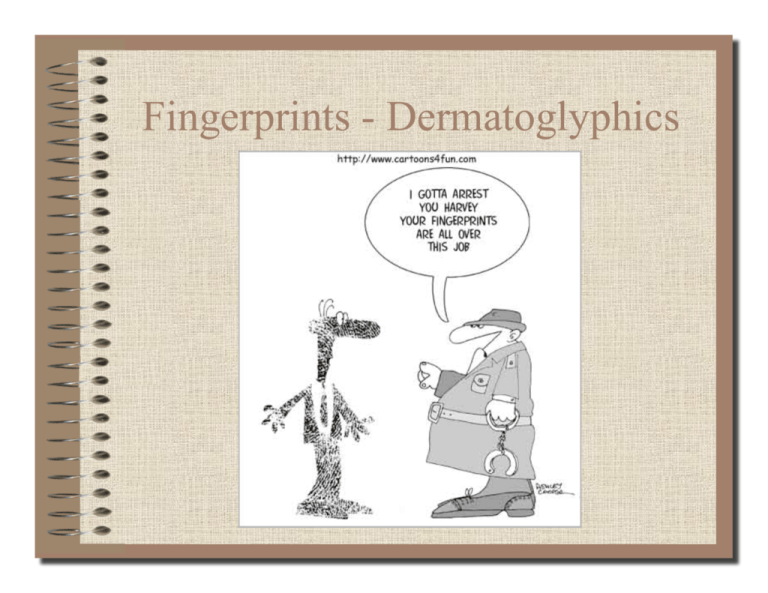
Fingerprints - Dermatoglyphics What Are Fingerprints? Raised ridges of skin on the hairless surfaces of hands and feet (Dermal Ridges) Primates and other animals have them Provide traction and every ridge contains a gland When Do Fingerprints Form? Begin to develop in the 10th week of gestation and are complete by the 24th week Chance, environment, and heredity all play a role in the development of an individuals fingerprints Three Principals of Fingerprints 1. A fingerprint is an individual characteristic a. No two fingers have the same fingerprint b. Identical twins are similar but not identical 2. Fingerprints remain unchanged during a lifetime 3. Fingerprints have general ridge patterns that permit them to be classified Three Types of Fingerprints Plastic Impressions. Made in soft material like butter, soap, etc. Visible Prints. Prints made when fingers have been covered in blood, dirt, oil, paint, etc. Latent Prints. Prints not visible to the human eye, hidden, unseen until treated. Methods for Making Latent Prints Visible. Chemical Methods – Iodine fuming – Ninhydrin – Silver Nitrate – Super Glue Fuming Powder Methods – Black Powder for light surfaces – White powder for dark surfaces Dusting for Fingerprints Three Classes of Fingerprints What Is a Delta? Loops 60% of the worlds population has them Ridges start on one side, rise towards the center, and return back to the side they started from Has 1 delta 2 types of loops • • Radial (thumb) Ulnar (pinkie) Arches 5% of the world’s population has them Start on one side, rise towards the center, then leave on the other side No deltas 2 Types of arches • • Plain Tented Whorls 35% of the worlds population has them Has some ridges that form circles or spirals Has 2 Deltas 4 types of whorls • • • • Plain Central Pocket whorl Double Loop Accidental whorl Four Types of Whorls Plain Whorl Double Loop Central Pocket Whorl Accidental Identify the Fingerprints Identification of Minutiae You must find 12 points of minutiae to match a print from a scene of a crime to a person’s print Label each with a number and a line to show its location Make a key at the bottom of the two prints Examples of Minutiae Identification of Minutiae 1. Bifurcation 2. Bifurcation 3. Bifurcation 4. Ridge Ending 5. Enclosure 6. Bifurcation 7. Bifurcation 8. Bifurcation 9. Ridge Ending Classification of Fingerprints Two International Systems Henry System – Used in North America and Europe Vucetich System – Used in Central and South America Identification is based on class and ridge patterns (minutiae) found on each individual print Henry Classification System Five different levels of classification Primary Classification Creates a fraction 25% of the world’s population is 1/1 RI + RR + LT + LM + LL + 1 RT RM RL LI LR 1 Whorl = 16,8,4,2,1 Arch and Loop = 0 Primary Classification Example A person has the following combination of prints on their ten fingers: RT=Arch LT=Loop RI=Whorl RM=Arch RR= Loop RL=Whorl LI=Arch LM=Whorl LR=Whorl LL=Arch RI/RT + RR/RM + LT/RL + LM/LI + LL/LR + 1/1 16/0 + 0/0 + 0/4 + 2/0 + 0/1 + 1/1 = 19/6 The Primary Classification is 19/6 Use the Henry System Loop Arch Arch Whorl Arch Loop Whorl Loop Loop Loop Automated Fingerprint Identification System Scan fingerprints into a computer database, which transforms it into digital minutiae. This is then used to identify unknown prints with several possible matches. In the end, a technician still makes the final ID of the unknown to the known print.



